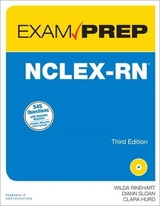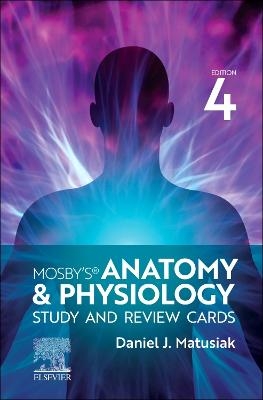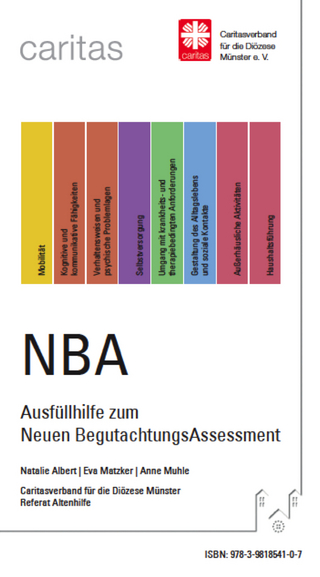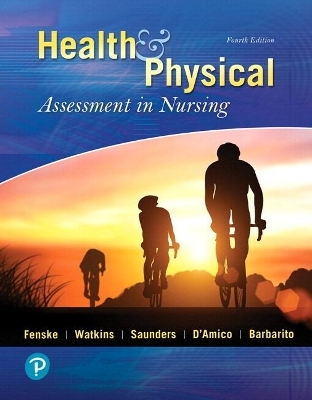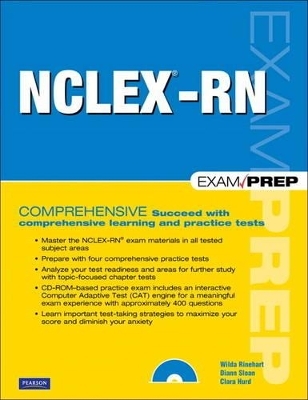
NCLEX-RN Exam Prep
Pearson IT Certification
978-0-7897-4527-9 (ISBN)
- Titel erscheint in neuer Auflage
- Artikel merken
Master the NCLEX-RN® exam materials in all tested subject areas
Prepare with four comprehensive practice tests
Analyze your test readiness and areas for further study with topic-focused chapter tests
CD-ROM—based practice exam includes an interactive Computer Adaptive Test (CAT) engine for a meaningful exam experience with approximately 400 questions
Learn important test-taking strategies to maximize your score and diminish your anxiety
Score Higher on the NCLEX®-RN Exam!
We provide you with the proven study tools and expert insight that will help you score higher on your exam.
Study Tips like the advice and instruction that a personal tutor might provide.
Notes, Tips, and Cautions provide you with hints and strategies that will help you reduce your mistakes on the exam.
Comprehensive discussion of all subject areas covered on RN Exam.
Practice Questions that include detailed explanations of correct and incorrect answers–so you can learn the material from your success and mistakes.
Rinehart and Associates is a leading provider of classroom training for students studying for the NCLEX® RN Exam.
CD Features Nearly 400 Questions!
The CD-ROM—based practice exam includes an interactive Computer Adaptive Test (CAT) engine for a meaningful exam experience with approximately 400 questions.
Live and Learn
Educating 100 million people worldwide, Pearson Education is the global leader in integrated education publishing.
Our renowned brands include:
Pearson Prentice Hall
Pearson Longman
Pearson Scott Foresman
Pearson Addison Wesley
Pearson NCS
Pearson Education provides quality content, assessment tools, and educational services in all available media, spanning the learning curve from birth through college and beyond.
CATEGORY: Medicine/Nursing COVERS: Nursing USER LEVEL: Intermediate
NCLEX-RN® and NCLEX-PN® are registered trademarks of the National Council of State Boards of Nursing, Inc. (NCSBN), which does not sponsor or endorse this product.
Wilda Rinehart received an associate’s degree in nursing from Northeast Mississippi Community College in Booneville, Mississippi. After working as a staff nurse and charge nurse, she became a public health nurse and served in that capacity for a number of years. In 1975, she received her nurse practitioner certification in the area of obstetrics-gynecology from the University of Mississippi Medical Center in Jackson, Mississippi. In 1979, she completed her bachelor of science degree in nursing from Mississippi University for Women. In 1980, she completed her master of science degree in nursing from the same university and accepted a faculty position at Northeast Mississippi Community College, where she taught medical-surgical nursing and maternal-newborn nursing. In 1982, she founded Rinehart and Associates Nursing Consultants. For the past 28 years, she and her associates have worked with nursing graduates and schools of nursing to help graduates pass the National Council Licensure Exam for Nursing. She has also worked as a curriculum consultant with faculty to improve test construction. Ms. Rinehart has served as a convention speaker throughout the southeastern United States and as a reviewer of medical-surgical and obstetric texts. She has coauthored materials used in seminars presented by Rinehart and Associates Nursing Review. As the president of Rinehart and Associates, she serves as the coordinator of a company dedicated to improving the quality of health through nursing education. Dr. Diann Sloan received an associate’s degree in nursing from Northeast Mississippi Community College, a bachelor of science degree in nursing from the University of Mississippi, and a master of science degree in nursing from Mississippi University for Women. In addition to her nursing degrees, she holds a master of science in counseling psychology from Georgia State University and a doctor of philosophy in counselor education, with minors in both psychology and educational psychology, from Mississippi State University. She has completed additional graduate studies in healthcare administration at Western New England College and the University of Mississippi. Dr. Sloan has taught pediatric nursing, psychiatric mental health nursing, and medical surgical nursing in both associate degree and baccalaureate nursing programs. As a member of Rinehart and Associates Nursing Review, Dr. Sloan has conducted test construction workshops for faculty and nursing review seminars for both registered and practical nurse graduates. She has coauthored materials used in the item-writing workshops for nursing faculty and Rinehart and Associates Nursing Review. She is a member of Sigma Theta Tau nursing honor society. Clara Hurd received an associate’s degree in nursing from Northeast Mississippi Community College in Booneville, Mississippi (1975). Her experiences in nursing are clinically based, having served as a staff nurse in medical-surgical nursing. She has worked as an oncology, intensive care, orthopedic, neurological, and pediatric nurse. She received her bachelor of science degree in nursing from the University of North Alabama in Florence, Alabama, and her master of science degree in nursing from the Mississippi University for Women in Columbus, Mississippi. Ms. Hurd is a certified nurse educator. She currently serves as a nurse educator consultant and an independent contractor and has taught in both associate degree and baccalaureate degree nursing programs. She was a faculty member of Mississippi University for Women; Austin Peay State University in Clarksville, Tennessee; Tennessee State University in Nashville; and Northeast Mississippi Community College. Ms. Hurd joined Rinehart and Associates in 1993. She has worked with students in preparing for the National Council Licensure Exam and with faculty as a consultant in writing test items. Ms. Hurd has also been a presenter at nursing conventions on various topics, including itemwriting for nursing faculty. Her primary professional goal is to prepare the student and graduate for excellence in the delivery of healthcare.
Introduction 1
Organization 2
Instructional Features 2
Extensive Practice Test Options 3
Final Review 3
Other Valuable Tools 3
About the NCLEX Exam 4
Advice for Preparing for the Exam 6
Advice for Test Day
Hints for Using This Book 7
Contact the Author 7
Study and Exam Preparation Tips 9
Study Tips 9
Exam Prep Tips 10
Read the Question Carefully 10
Look for Keywords 11
Watch for Specific Details 11
Eliminate Options That Are Clearly Wrong or Incorrect 11
Look for Similar Options 11
Look for Opposite Answers 12
Part I: Exam Preparation
Chapter 1: Pharmacology 15
Three Areas of Pharmacology 15
How Nurses Work with Pharmacology 16
Time-released Drugs 17
Administering Medications 18
The Seven Rights of Administering Medication 18
Understanding and Identifying the Various Drugs 19
Angiotensin-Converting Enzyme Inhibitors 19
Beta Adrenergic Blockers 20
Anti-Infectives (Aminoglycosides) 21
Benzodiazepines (Anticonvulsants/Antianxiety) 23
Phenothiazines (Antipsychotic/Antiemetic) 24
Glucocorticoids 25
Antivirals 27
Cholesterol-Lowering Agents 28
Angiotensin Receptor Blockers 29
Histamine 2 Antagonists 30
Proton Pump Inhibitors 31
Anticoagulants 32
More Drug Identification Helpers 33
Herbals 34
Drug Schedules 35
Pregnancy Categories for Drugs 35
Key Concepts 36
Key Terms 36
Apply Your Knowledge 37
Answer Rationales 39
Chapter 2: Fluid and Electrolyte and Acid/Base Balance 41
Total Body Water Calculation 41
Management of the Client with Imbalances in Fluid and Electrolytes 43
Types of Intravenous Fluids 43
How the Body Regulates Electrolytes 44
How the Body Regulates pH 52
Key Concepts 60
Key Terms 60
Diagnostic Tests 60
Pharmacological Agents Used in the Treatment of Clients with Alterations in Fluids and Electrolytes 60
Apply Your Knowledge 61
Exam Questions 62
Answers to Exam Questions 64
Suggested Reading and Resources 65
Chapter 3: Care of the Client with Cardiovascular Disorders 67
Hypertension 68
Diagnosing the Client with Hypertension 69
Managing the Client with Hypertension 69
Coronary Artery Disease 71
Atherosclerosis and Arteriosclerosis 71
Conduction System of the Heart 72
Heart Block 73
Cardiac Monitoring 74
Reading an Electrocardiogram 75
Cardiac Dysrhythmias 76
Ventricular Tachycardia 77
Ventricular Fibrillation 78
Internal Pacemaker/Internal Cardiac Defibrillators 79
Cardiopulmonary Resuscitation 80
Angina Pectoris 80
Myocardial Infarction 81
Diagnosis of Myocardial Infarction 82
Management of a Client with Myocardial Infarction 82
Aneurysms 89
Inflammatory Diseases of the Heart 90
Infective Endocarditis 90
Pericarditis 90
Peripheral Vascular Disease 91
Varicose Veins/Thrombophlebitis 92
Raynaud’s Phenomenon 92
Buerger’s Disease 92
Key Concepts 94
Key Terms 94
Diagnostics 95
Pharmacological Agents Used in the Treatment of Clients with Cardiovascular Disorders 96
Apply Your Knowledge 101
Exam Questions 101
Answers to Exam Questions 103
Suggested Reading and Resources 104
Chapter 4: Care of the Client with Endocrine Disorders 105
Pituitary Gland 106
Hypopituitarism 106
Hyperpituitarism 106
Disorders of the Posterior Pituitary Gland 107
Thyroid Disorders 108
Hypothyroidism 108
Hyperthyroidism 110
Parathyroid Disorders 112
Hypoparathyroidism 112
Hyperparathyroidism 113
Diabetes Mellitus 114
Hyperglycemia 116
Hypoglycemia 117
Managing Hyperglycemia and Hypoglycemia 117
Adrenal Gland 118
Adrenal Gland Disorders 119
Key Concepts 123
Key Terms 123
Diagnostics 124
Pharmacological Agents Used to Treat Clients with Endocrine Disorders 124
Apply Your Knowledge 128
Exam Questions 128
Answers to Exam Questions 130
Suggested Reading and Resources 131
Chapter 5: Care of the Client with Respiratory Disorders 133
Noninfectious Disorders of the Lower Respiratory Tract 133
Chronic Bronchitis 133
Emphysema 134
Asthma 135
Pleurisy 137
Pulmonary Hypertension 138
Interstitial Pulmonary Disease 139
Sarcoidosis 139
Pulmonary Fibrosis 140
Occupational Pulmonary Disease 140
Infectious Disorders of the Lower Respiratory Tract 142
Pneumonia 142
Tuberculosis 145
Influenza 147
Life-Threatening Pulmonary Disorders 148
Acute Respiratory Distress Syndrome 148
Pulmonary Embolus 152
Pneumothorax 154
Hemothorax 155
Emerging Infections 158
SARS 158
Legionnaires’ Disease 159
Key Concepts 161
Key Terms 161
Diagnostic Tests 161
Pharmacological Agents Used in the Care of the Client with Disorders of the Respiratory System 162
Apply Your Knowledge 165
Exam Questions 166
Answers to Exam Questions 168
Suggested Reading and Resources 169
Chapter 6: Care of the Client with Genitourinary Disorders 171
Renal Disorders 172
Acute Glomerulonephritis 172
Chronic Glomerulonephritis 173
Goodpasture’s Syndrome 174
Nephrotic Syndrome 175
Polycystic Kidney Disease 176
Hydronephrosis/Hydroureteronephrosis 177
Pyelonephritis 178
Acute and Chronic Renal Failure 179
Chronic Renal Failure 180
Peritoneal Dialysis 181
Hemodialysis 182
Continuous Renal Replacement Therapy 183
Renal Transplantation 184
Urinary Disorders 185
Cystitis 185
Urinary Incontinence 187
Urolithiasis 188
Genitourinary Disorders 189
Prostatitis 190
Benign Prostatic Hypertrophy 190
Erectile Dysfunction 191
Epididymitis 193
Priapism 193
Key Concepts 195
Key Terms 195
Diagnostics 195
Pharmacologic Agents for the Client with Genitourinary Disorders 196
Apply Your Knowledge 200
Exam Questions 200
Answers to Exam Questions 202
Suggested Reading and Resources 203
Chapter 7: Care of the Client with Integumentary Disorders 205
Common Infections of the Integumentary System 205
Viral Infections 205
Fungal Infections 207
Bacterial Infections 208
Psoriasis 208
Pressure Ulcers 209
Burns 212
Burn Classifications 212
Burn Measurement with TBSA 214
Nursing Care for Burn Victims 215
Key Concepts 223
Key Terms 223
Diagnostic Tests 223
Pharmacological Agents Used in the Care of the Client with Integumentary Disorders 224
Apply Your Knowledge 226
Exam Questions 226
Answers to Exam Questions 228
Suggested Reading and Resources 229
Chapter 8: Care of the Client with Sensory Disorders 231
Disorders of the Eyes 231
Intraocular Disorders 232
Uveitis 235
Retinal Disorders 236
Refractive Errors 239
Traumatic Injuries 240
Ocular Melanoma 240
Disorders of the Ears 242
Otitis Externa 243
Otitis Media 243
Mastoiditis 244
Ménière’s Disease 244
Acoustic Neuroma 245
Otosclerosis 245
Presbycusis 246
Ear Trauma 246
Assisting Clients with Hearing Loss 247
Key Concepts 250
Key Terms 250
Diagnostic Tests 251
Pharmacological Agents Used in the Care of the Client with Disorders of the Eyes and Ears 251
Apply Your Knowledge 253
Exam Questions 253
Answers to Exam Questions 255
Suggested Reading and Resources 256
Chapter 9: Care of the Client with Gastrointestinal Disorders 257
Peptic Ulcer Disease 258
Types of Ulcers 259
Diagnosis of Ulcers 259
Treatment of Ulcers 260
Inflammatory Bowel Disorders 263
Crohn’s Disease 263
Ulcerative Colitis 263
Management of the Client with Inflammatory Bowel Disease 264
Diverticular Disease 265
Management of the Client with Diverticulitis 265
Hemorrhoids 266
Appendicitis 266
Peritonitis 268
Intestinal Obstruction 269
Esophageal Disorders 270
GERD 270
Hiatal Hernia 274
Diseases Associated with the Liver 275
Hepatitis 275
Cirrhosis 281
Acute Pancreatitis 285
Diagnosis of Pancreatitis 286
Treatment of Pancreatitis 286
Cholecystitis/Cholelithiasis 287
Symptoms of Cholecystitis and Cholelithiasis 288
Diagnosis of Cholecystitis/Cholelithiasis 288
Treatment of Cholecystitis 289
Treatment of Cholethiasis 289
Clostridium Difficile 290
Food-Borne Illnesses 291
Key Concepts 294
Key Terms 294
Diagnostic Tests 295
Pharmacological Agents Used in the Care of the Client with Disorders of the Gastrointestinal System 295
Apply Your Knowledge 297
Exam Questions 298
Answers to Exam Questions 300
Suggested Reading and Resources 301
Chapter 10: Care of the Client with Hematological Disorders 303
Anemia 303
Pernicious Anemia 304
Aplastic Anemia 304
Sickle Cell Anemia 305
Iron Deficiency Anemia 309
Thalassemia 311
Polycythemia Vera 312
Hemophilia 313
Transfusion Therapy 315
Transfusion Reactions 317
Key Concepts 319
Key Terms 319
Diagnostic Tests for Review 319
Pharmacological Agents Used in Hematological Disorders 320
Apply Your Knowledge 321
Exam Questions 321
Answers to Exam Questions 323
Suggested Reading and Resources 324
Chapter 11: Care of the Client with Disorders of the Neurological System 325
Neurological Assessment 326
Cranial Nerve Assessment 326
Glasgow Coma Scale 327
Intracranial Pressure Monitors 328
Brain Injuries 329
Epidural Hematomas 332
Subdural Hematoma 332
Intracerebral Hematomas 332
Treatment of Hematomas 332
Increased Intracranial Pressure 332
Brain Tumors 336
Treatment of Brain Tumors 337
Care of the Client with Intracranial Surgery (Craniotomy) 338
Cerebrovascular Accident/Stroke 342
Ischemic Stroke 342
Hemorrhagic Stroke 344
Seizures 347
Types of Seizures 347
Treatment of Seizure Clients 350
Parkinson’s Disease 350
Meningitis 352
Autoimmune Neurological Disorders 354
Multiple Sclerosis 354
Myasthenia Gravis 355
Guillain-Barré 357
Degenerative Neurological Disorders 358
Cranial Nerve Disorders 359
Trigeminal Neuralgia 359
Bell’s Palsy 359
Spinal Cord Injuries 360
Treatment of Spinal Cord Injuries 361
Potential Complications with SCI Clients 362
Intervertebral Disk Disease 363
Diabetes Insipidus 365
Key Concepts 367
Key Terms 367
Diagnostics 368
| Erscheint lt. Verlag | 9.9.2010 |
|---|---|
| Verlagsort | Upper Saddle River |
| Sprache | englisch |
| Maße | 215 x 274 mm |
| Gewicht | 2214 g |
| Themenwelt | Medizin / Pharmazie ► Pflege |
| ISBN-10 | 0-7897-4527-5 / 0789745275 |
| ISBN-13 | 978-0-7897-4527-9 / 9780789745279 |
| Zustand | Neuware |
| Haben Sie eine Frage zum Produkt? |
aus dem Bereich
